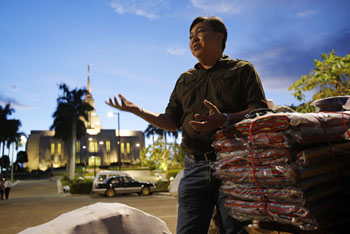Church Members Rally to Aid Typhoon Victims in Philippines
Contributed By By Jesse Hyde, Deseret News

Church members, volunteers, and missionaries work to prepare relief supplies in Cebu City, Wednesday, November 20, 2013, for people in need following a typhoon in the Philippines.
Related Links
CEBU CITY, PHILIPPINES
Pinky Meneses stands with her hand on her hip, her head cocked to the side, looking at a checklist of supplies.
Three cans of corned beef.
Three cans of meat loaf.
And three cans of sausage.
Before she finishes looking at the list, Sister Meneses hurries across the gym floor, past a row of boxes packed with powdered milk, until arriving at what is normally a classroom in this LDS chapel in the Philippines.
Today the chairs have been cleared out to make way for an assembly line of sorts. Members of the Relief Society and Young Women sit side by side on the floor, pouring buckets of rice into clear plastic bags, as young men and elders carry more rice in heavy sacks from trucks parked outside.
Sister Meneses, a member of the local Relief Society, is supervising much of the effort tonight, and she will make sure the meat loaf and sausage, the sardines, and the corned beef get in the aid packages too.
On this Wednesday night in Cebu City, 350 miles south of Manila, the members of five stakes have gathered to assemble cooking kits, package food, and fold sleeping mats and mosquito nets that will be shipped to neighboring islands that were hit hardest by Typhoon Haiyan.
It’s just a small part of the Church’s relief effort in the Philippines, which has been underway from the moment the waters receded after the November 8 superstorm, one of the largest in the country’s history.
The typhoon killed more than 4,000 people and displaced more than half a million. As it churned along the western seaboard of this island archipelago, an estimated 15,000 Church members sought refuge in 200 chapels within the storm path.
While some buildings suffered structural damage, no one who sheltered inside the chapels was killed or seriously injured, and within a few days the 205 missionaries in the Philippines Tacloban Mission were all accounted for and safe. Bishops here have determined 36 members died in the storm.

Project manager Jairus Perez of Humanitarian Services for the Church is interviewed as members, volunteers, and missionaries work to prepare relief supplies in Cebu City, Philippines, Wednesday, November 20, 2013. Photo by Ravell Call, Deseret News.
The Church is now working with bishops and stake presidents to assess the needs in areas hit hardest by the storm and had sent more than 45,000 pounds of food by midweek.
Temporary bishops have been called in Manila and Cebu City to watch over the flood of refugees arriving by military transport and boats from the storm zone. These bishops help refugees find a place to live and assist those who will never be able to return to their homes find work and, in some cases, new schools for their children. The temporary bishop in Cebu said a new family arrives from the Tacloban area, where the storm hit hardest, almost every night.
Back at the meetinghouse in Cebu, Sister Meneses is showing a group of American missionaries who just arrived from the missionary training center where to put boxes of sardines. When she finishes with them, she rushes back to the classroom to check in on the members of the Relief Society bagging rice.
“It’s important that everyone in the Church serves,” she says, pointing at two priests carrying sacks of sugar. “When you see what the people lost [in the storm], it makes you realize how much you’ve been blessed.”
Her husband is the bishop of the Kamputhaw Ward, and she beams as she points out how many members of their ward are here tonight.
Among those assembling food kits are eight members—and three generations—of the Cinco and Rosales families, who had to leave their home in Tacloban after the storm. They survived, they say, largely because of preparations they made beforehand.
“It’s because of the doctrine of the Church,” said Cesar Rosales, who recently served as an elders quorum president in the Tacloban 2nd Ward. “The principle of food storage, of healthy eating, the doctrine of prayer and faith. These are the reasons we survived.”
He recounts the harrowing days after the storm and the long journey from Tacloban to Cebu, where his family is now staying with another member. And then he says he has to go. The rest of his family is packing rice and folding blankets, and he needs to pitch in because there are people back home who are in need.

